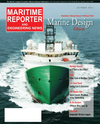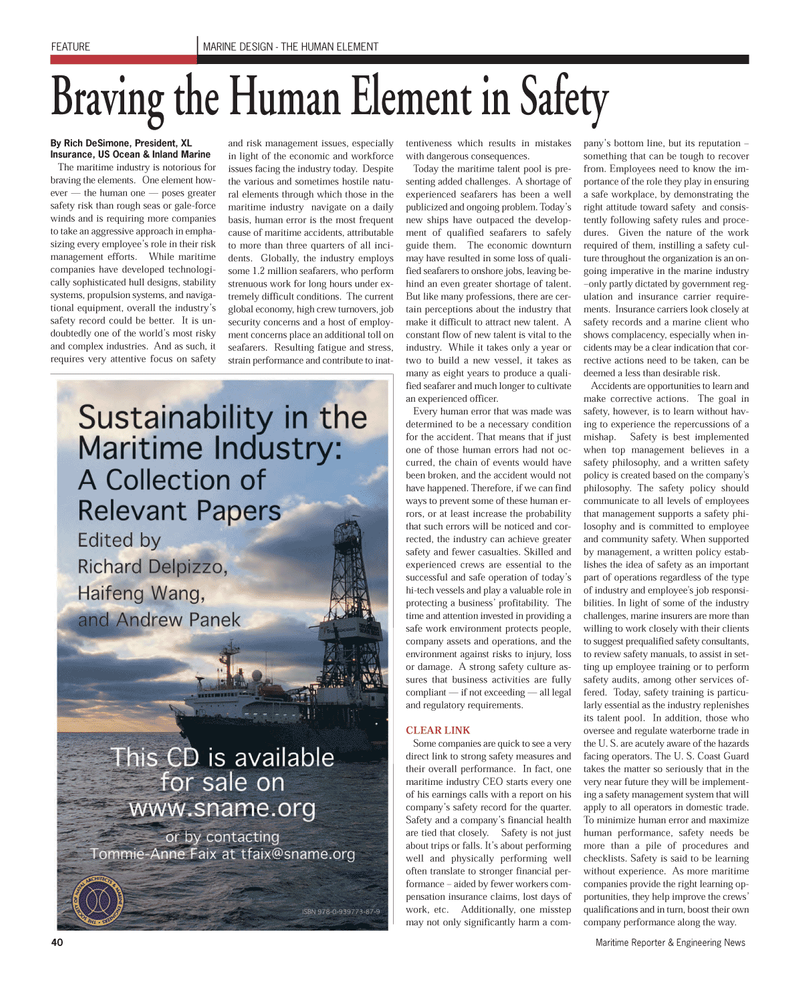
Page 40: of Maritime Reporter Magazine (October 2011)
Marine Design Annual
Read this page in Pdf, Flash or Html5 edition of October 2011 Maritime Reporter Magazine
By Rich DeSimone, President, XL Insurance, US Ocean & Inland Marine The maritime industry is notorious forbraving the elements. One element how- ever ? the human one ? poses greater safety risk than rough seas or gale-force winds and is requiring more companiesto take an aggressive approach in empha- sizing every employee?s role in their risk management efforts. While maritime companies have developed technologi- cally sophisticated hull designs, stabilitysystems, propulsion systems, and naviga- tional equipment, overall the industry?s safety record could be better. It is un- doubtedly one of the world?s most risky and complex industries. And as such, it requires very attentive focus on safety and risk management issues, especiallyin light of the economic and workforce issues facing the industry today. Despite the various and sometimes hostile natu- ral elements through which those in themaritime industry navigate on a daily basis, human error is the most frequentcause of maritime accidents, attributable to more than three quarters of all inci-dents. Globally, the industry employs some 1.2 million seafarers, who perform strenuous work for long hours under ex- tremely difficult conditions. The current global economy, high crew turnovers, job security concerns and a host of employ- ment concerns place an additional toll onseafarers. Resulting fatigue and stress, strain performance and contribute to inat- tentiveness which results in mistakes with dangerous consequences. Today the maritime talent pool is pre- senting added challenges. A shortage of experienced seafarers has been a well publicized and ongoing problem. Today?s new ships have outpaced the develop- ment of qualified seafarers to safely guide them. The economic downturn may have resulted in some loss of quali- fied seafarers to onshore jobs, leaving be- hind an even greater shortage of talent. But like many professions, there are cer- tain perceptions about the industry thatmake it difficult to attract new talent. A constant flow of new talent is vital to the industry. While it takes only a year or two to build a new vessel, it takes as many as eight years to produce a quali- fied seafarer and much longer to cultivate an experienced officer. Every human error that was made was determined to be a necessary conditionfor the accident. That means that if just one of those human errors had not oc-curred, the chain of events would have been broken, and the accident would not have happened. Therefore, if we can find ways to prevent some of these human er- rors, or at least increase the probabilitythat such errors will be noticed and cor- rected, the industry can achieve greater safety and fewer casualties. Skilled and experienced crews are essential to the successful and safe operation of today?s hi-tech vessels and play a valuable role in protecting a business? profitability. The time and attention invested in providing a safe work environment protects people, company assets and operations, and the environment against risks to injury, loss or damage. A strong safety culture as- sures that business activities are fully compliant ? if not exceeding ? all legal and regulatory requirements. CLEAR LINK Some companies are quick to see a very direct link to strong safety measures andtheir overall performance. In fact, one maritime industry CEO starts every one of his earnings calls with a report on hiscompany?s safety record for the quarter. Safety and a company?s financial health are tied that closely. Safety is not just about trips or falls. It?s about performing well and physically performing well often translate to stronger financial per- formance ? aided by fewer workers com- pensation insurance claims, lost days ofwork, etc. Additionally, one misstep may not only significantly harm a com- pany?s bottom line, but its reputation ? something that can be tough to recover from. Employees need to know the im- portance of the role they play in ensuring a safe workplace, by demonstrating the right attitude toward safety and consis- tently following safety rules and proce- dures. Given the nature of the work required of them, instilling a safety cul-ture throughout the organization is an on- going imperative in the marine industry ?only partly dictated by government reg- ulation and insurance carrier require-ments. Insurance carriers look closely atsafety records and a marine client whoshows complacency, especially when in- cidents may be a clear indication that cor- rective actions need to be taken, can be deemed a less than desirable risk.Accidents are opportunities to learn andmake corrective actions. The goal in safety, however, is to learn without hav- ing to experience the repercussions of a mishap. Safety is best implementedwhen top management believes in a safety philosophy, and a written safety policy is created based on the company's philosophy. The safety policy should communicate to all levels of employees that management supports a safety phi-losophy and is committed to employee and community safety. When supported by management, a written policy estab- lishes the idea of safety as an importantpart of operations regardless of the type of industry and employee's job responsi- bilities. In light of some of the industrychallenges, marine insurers are more thanwilling to work closely with their clients to suggest prequalified safety consultants, to review safety manuals, to assist in set- ting up employee training or to perform safety audits, among other services of-fered. Today, safety training is particu- larly essential as the industry replenishesits talent pool. In addition, those whooversee and regulate waterborne trade in the U. S. are acutely aware of the hazards facing operators. The U. S. Coast Guard takes the matter so seriously that in the very near future they will be implement- ing a safety management system that willapply to all operators in domestic trade.To minimize human error and maximize human performance, safety needs bemore than a pile of procedures andchecklists. Safety is said to be learningwithout experience. As more maritime companies provide the right learning op- portunities, they help improve the crews? qualifications and in turn, boost their own company performance along the way. FEATURE Braving the Human Element in Safety MARINE DESIGN - THE HUMAN ELEMENT40Maritime Reporter & Engineering News MR Oct.11 # 5 (34-41):MR Template 10/5/2011 10:50 PM Page 40

 39
39

 41
41
